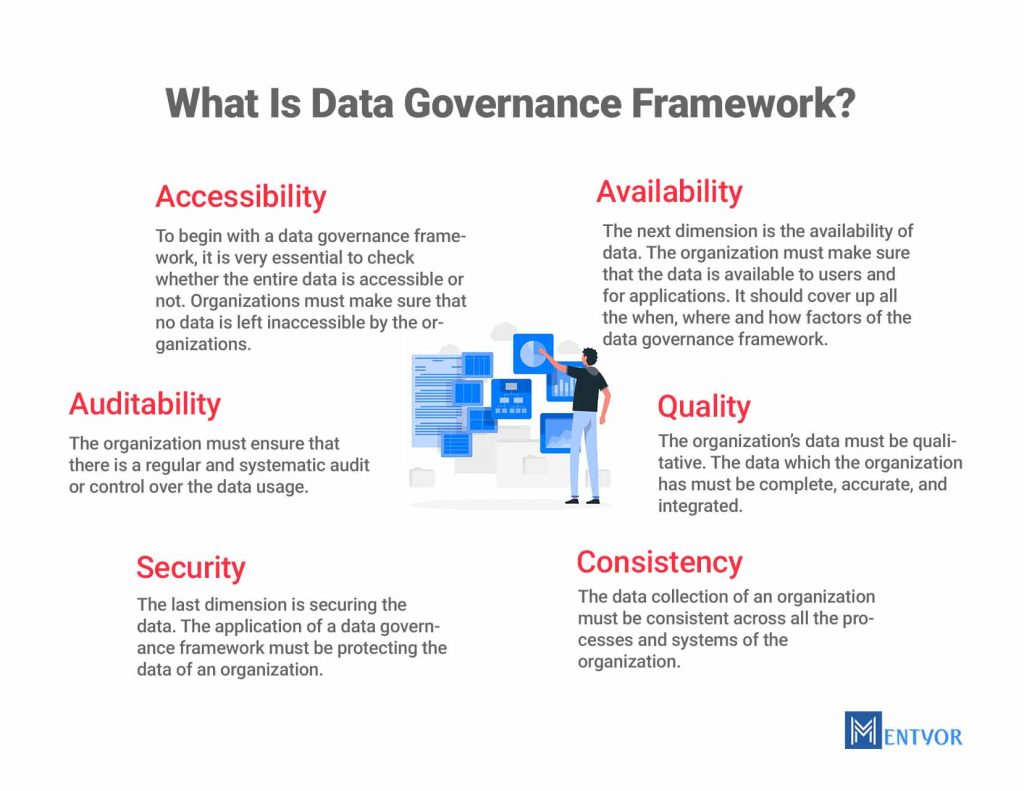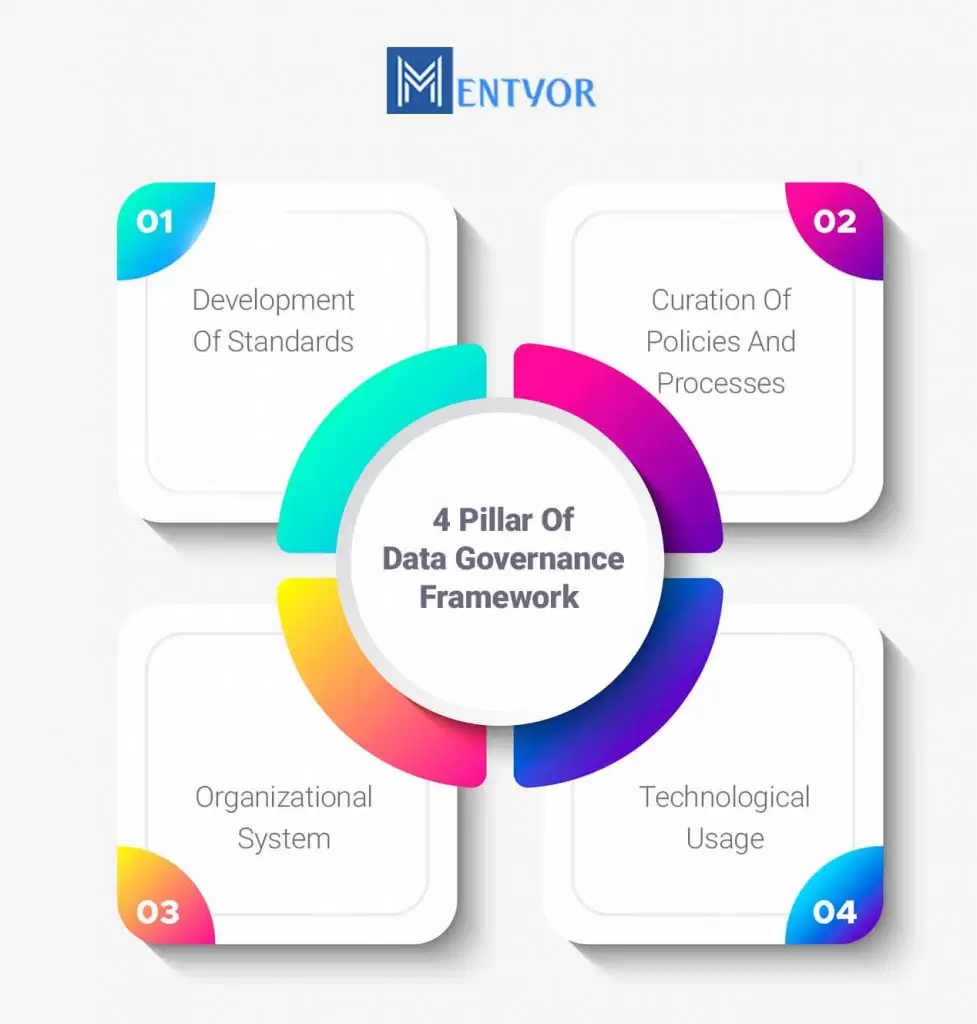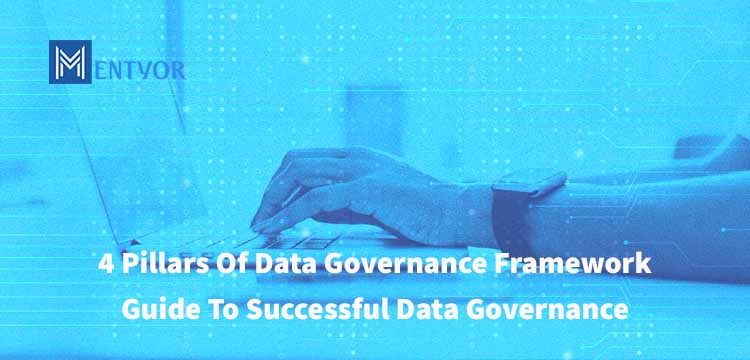With data and information increasing rapidly, it has become a mammoth task for the organization to govern them. This has majorly contributed to the emergence and use of data governance. Data governance has made it easier for us to store and secure qualitative information. Just like a security guard that guards our homes, data governance does the same for us. It is defined as “A companywide framework for assigning decision-related rights and duties to be able to adequately handle data as a company asset” [1].
To use the data governance framework, familiarization with a few things is necessary. The implementation of data governance framework continues to happen across various fields. However, one thing is common in all these usages, that is, to protect the data and information at all costs. If you look across different data governance examples, you will find the organizations working to ensure that the data is safe, qualitative, and free from all discrepancies.
The importance of data governance framework holds a great deal for various organizations and companies. Applying the framework is the next thing after knowing what data governance is. For this, the 4 pillars of the data governance framework must be familiar before application. Before we dive into knowing these 4 pillars, let us know what a data governance framework is in detail.
Know about Supply Chain Management for business: What Is Supply Chain Management ? [3 Examples + Advantages]
Takeaway
The world is swirling with lots of information and data. In this, it becomes a hasty task for the organization to keep its data real and safe. To do this, the advent of data governance has completed the required need. But, data governance requires the first step of the data governance framework.
What Is Data Governance Framework?

A data governance framework refers to the framework which guides the organization or company to apply its policies for the data. It is called the strong borders of all the enterprises that wish to successfully apply data governance. The framework assists in applications and re-use of software and systems. It performs the function of helping by providing information of rules and regulations of data governance in an organization. The importance of data governance framework also stands for the process of development, usage, and managing of data [2]. It aids in setting up standardization for data and creating the right organizational structure for its use and application [2].
The data governance framework works around six dimensions to achieve the overall data accomplishment. These six dimensions work as the guiding channels for the implementation of data governance framework [2]. These six dimensions are:
Accessibility
To begin with a data governance framework, it is very essential to check whether the entire data is accessible or not. Organizations must make sure that no data is left inaccessible by the organizations.
Availability
The next dimension is the availability of data. The organization must make sure that the data is available to users and for applications. It should cover up all the when, where and how factors of the data governance framework.
Quality
The organization’s data must be qualitative. The data which the organization has must be complete, accurate, and integrated.
Consistency
The data collection of an organization must be consistent across all the processes and systems of the organization.
Auditability
The organization must ensure that there is a regular and systematic audit or control over the data usage.
Security
The last dimension is securing the data. The application of a framework must be protecting the data of an organization.
The framework is used differently across varied subjects. In small and medium enterprises, the importance of data governance framework is more challenging. Small and medium enterprises are subject to the formation and maintenance of data in a constrained budget. The application of a data governance framework in this situation turns out to be a hurdle [3].
Data governance framework from a citizen-centered perspective in a smart city is framed to be used as an asset. The data is secured and used to create value for the citizens. A coherent framework is formed to cover ethical and legitimacy challenges [4]. These challenges arise at various stages of data-based value creation [4].
The implementation of data governance framework, however, services common needs across various fields too. It works around the quality of access to data and protection to it. With a framework, the process to successfully implement data governance becomes easier.
Takeaway
A data governance framework refers to the framework which guides the organization or company to apply its policies for the data. It is called the strong borders of all the enterprises that wish to successfully apply data governance. Every data governance framework consists of six dimensions to be achieved.
Read our blog about Information Literacy: Learn “What is information literacy? ” – in 5 easy steps
Purpose Of Data Governance Framework

Be it the IT field or the corporate businesses, data governance is being used everywhere. The crust for the application of the data governance framework lies in securing data that is valuable and reliable. Several purposes are served with a successful curation of the framework. Below are the purposes served with the successful implementation of data governance framework.
- Data governance framework assists in the successful execution of data governance. This is done by listing out the essential cores of the data governance plan.
- Data governance framework helps in successful implementation that improves data quality.
- The purpose of the data framework also serves in tackling data issues and discrepancies.
- The implementation of data governance framework helps in listing out the data owners in the organization.
- Designing a data governance framework helps in building a successful data catalog.
- The importance of data governance framework helps in the curation of reference and master data.
- Data governance framework helps in proctoring the data policies and successful application of them.
- Data governance framework becomes the ideal way in pushing forward data literacy.
- The implementation of data governance framework aids in delivering and positioning data appropriately.
The purpose of a data governance framework extends to understanding the consequences and results of data governance. It helps the organization to keep modifying its data governance framework strategy. All these can be done, with the help of understanding how good the application of data governance works.
Takeaway
Data governance framework serves various purposes. Right from data programming to data quality checks, everything about data is served by a data governance framework. It helps in understanding the organization’s progress and the near consequences of application.
4 Pillar Of Data Governance Framework

The successful data governance framework works around 4 pillars [2]. While framing a layout for data governance, it is very important to design it around these pillars. By doing so, you achieve the basic requirements for data governance to work for you, the organization, and users.
Below is a detailed elaboration on the 4 pillars of the data governance framework that must be applied.
Development Of Standards
The first and foremost pillar of the data governance framework is standard creation. This standardization must be curated in response to the query of ‘why the data must be from your organization’. In this pillar, the organization must involve themselves in defining their data definitions. The definition for the master data of the organization must also be established. Apart from this, the curation of taxonomies, enterprise data models, and other technical stands must be formed. With this successful application of the first pillar, the organization will have its basic language of communication too. Standardization will also help the data information to be unique and reliable.
Curation Of Policies And Processes
An effective data governance framework works on setting the best policies and processes for the future. Under this pillar, the organization has to frame the policies surrounding data management, usage, and execution. Along with this, it must decide upon the suitable processes too. The rules for data-related business must be defined and there must be managed for changes in data. With this, the control or audit for the data must be decided upon too. This pillar also emphasizes the need for accessibility and delivery of data with all measured mechanisms.
Organizational System
The main challenge that any enterprise or organization faces is framing the organizational structure for its data governance. This is why it has been included as one of the pillars of the framework. This pillar emphasizes organizations define the roles and responsibilities related to data accountability. These divisions of roles can go up to several degrees, including business and IT staffs too. To keep the data governance plan in sync, the organizational system must also solve the management issues. With pre-defining of the roles and responsibilities, it will be easier for the organization to know who is doing what. There must also be executive councils and separate day-to-day implementers for the data governance framework.
Technological Usage
The last pillar of the data governance framework is the use of technology. Somewhere, technology has fastened the use of data governance and its tools. However, there are some note points to keep in mind while using technology for the same. The technological infrastructure for the framework should be suitable for the policies. Based on the policies, the organizations must decide upon the technological tools like spreadsheets, etc. using technology in data governance framework can help inappropriate enforcement of standards and audits. It can also help in streamlining the solutions earlier to avoid any malfunction while final execution of data governance plans.
These are the 4 pillars of the data governance framework. The application of these pillars extends assurance to all the aspects under data governance. It ensures that the plan for data governance runs smoothly with no interventions curbing it. The implementation of data governance framework must be securing the protection, usage, and management of data. It works as the preface before there is complete execution of the data governance plans.
Takeaway
There are 4 pillars of the data governance framework. Implementation of these pillars will ensure that the data governance plans run smoothly in the long term. These 4 pillars are:
- Development of Standards
- Curation of Policies and Processes
- Organizational System
- Technological Usage
Know what is Data Science and Data Analytics: Difference Between Data Science And Data Analytics: A Complete Breakdown
Parting Note
The data governance framework is an essential step for the execution of data governance. With so many organizations and companies switching to data governance, we can see so many framework examples around us. The importance of data governance framework has grown because it is essentially putting safety belts before the ride. With the implementation of data governance framework, we can easily ensure that our initiatives for data governance go well.
Data governance framework refers to the outlining of data governance plans. It is the formation of technological processes, tools, rules, and periods for the execution of data governance plans. It aids in setting out the structure and organizational pattern for the organization to execute data governance. Along with this, the data governance framework revolves around six dimensions. These dimensions are availability, accessibility, consistency, quality, auditability, and security. Every initiative of the framework must include these six dimensions.
Apart from these, the implementation of data governance framework includes 4 essential pillars. These pillars work as the guiding channels for the working of data governance in the long term. These 4 pillars of the data governance framework are standardization, process and policies, organization, and technology. With this, the importance of data governance framework also implies several serving purposes. These purposes include data programming, data security, data management issues, and many more.
In a nutshell, a framework resembles the protecting borders for any organization that hopes to successfully operate data governance.
Common FAQs
- What is the importance of data governance?
Data governance provides the much-needed security and organizational structure to data and information. It helps the company or the organization to sort out its policies, procedures, and plans for its collected data. Data governance has become an easier and more advanced pattern to conserve the quality and security of data.
- What are the four models of governance?
The four models of governance are:
- Advisory model
- Policy Board model
- Management Team model
- Cooperative model
- What is effective data governance?
Effective data governance refers to modeling out the usage of data, management for it, and procedure to execute the same. Effective data governance fulfills the parameters that revolve in and around data. This includes maintaining the security, quality, and appropriate quantity of data.
References
[1] Alhassan, I., Sammon, D., & Daly, M. (2016). Data governance activities: an analysis of the literature. Journal of Decision Systems, 25(sup1), 64-75.
[2] Panian, Z. (2010). Some practical experiences in data governance. World Academy of Science, Engineering and Technology, 62(1), 939-946.
[3] Begg, C., & Caira, T. (2012). Exploring the SME Quandary: Data Governance in Practise in the Small to Medium‑Sized Enterprise Sector. Electronic Journal of Information Systems Evaluation, 15(1), pp3-13.
[4] König, P. D. (2021). Citizen-centered data governance in the smart city: From ethics to accountability. Sustainable Cities and Society, 75, 103308.


 WhatsApp
WhatsApp